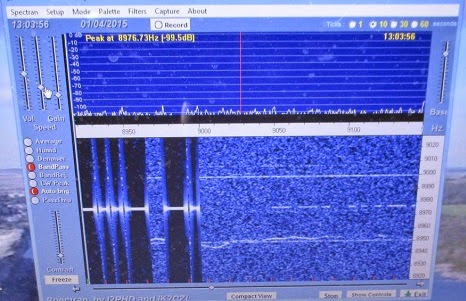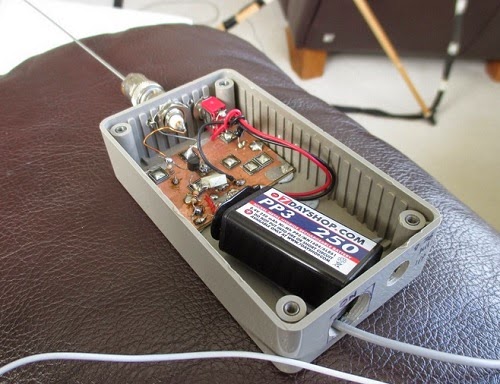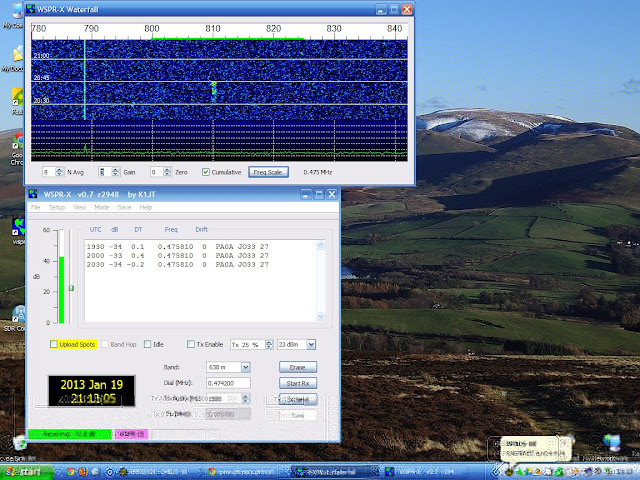Posts Tagged ‘VLF’
 VLF field test tomorrow
VLF field test tomorrow
Today I adjusted the turns ratio on my 8.976kHz VLF QRSS3 and 10wpm CW 5W beacon to better match my earth electrodes. At this QTH they look much greater than 50 ohms, which I measured at the “old” QTH and optimised for.
On the way I managed to blow up a TDA2003 IC, which I had to replace. The whole exercise was far more exhausting than I was expecting. It seems that after about 10-15 minutes of physical or mental effort I am done in. Before my cerebellum brain bleed everything today would have been trivial. Now trivial tasks feel like climbing mountains! Although I can see progress in my recovery there is still a long way to go. One of my aims (among many) is to be able to resume field tests as before, but time will tell if I am really up to this: it is quite hard when your brain is still foggy a lot of the time. Oddly, when sitting down at home or when driving things are fine. It is when I do something requiring real physical or mental effort that I get tired. I guess the radio work today was hard as I had not done this sort of thing for some time.
Anyway, the good news is that I hope to do a VLF field test tomorrow. Everything is ready and tested. It will not be until late afternoon as both my wife and I are busy before then. The XYL will be there at the test site if I get really tired. Setting up the gear will be especially tiring in my current state. The test site is not too far from home. I have soak tested the TX and it should be fine on QRSS3 using my loop and Spectran at the RX end. I shall report results tomorrow. This will be my first VLF field test in over 18 months. How I have looked forward to this. If the loop is successful I may try the E-field probe.
 First (restarted) VLF earth-mode test
First (restarted) VLF earth-mode test
 |
| 5W VLF beacon TX |
OK, I was only testing from the shack to the lounge, but this is a start. TX is 5W from my TDA2003 beacon.
TX frequency 8.976kHz initially with 10wpm CW, 300Hz bandwidth, sending my callsign and a dash. Nothing copied at first using a dummy load but over 70dB over noise using the earth-electrode “antenna” with no attempt to optimise match (fed via the same 3C90 step-up transformer used on 472kHz). With no probe at all (i.e.no RX antenna) the S/N was still some 40dB i.e. very good using the TX into the earth-electrodes.
 |
| QRSS3 signal received on Spectran (0.37Hz BW) |
Later with QRSS3, a 50 ohm TX dummy load, E-field probe at the RX, I got the signal at 10-20dB S/N. At the RX end I was using my simple E-field probe into a USB soundcard into my Windows 8.1 laptop.
 |
| E-field probe |
The blue photo shows the signal at the RX. The first part shows the TX signal on the earth-electrodes and the second part (weaker) was the signal on the EFP with the TX into a dummy load.
Honestly, this has really exhausted me!
 Tubular Bells and VLF interference
Tubular Bells and VLF interference
 Remember that album from Mike Oldfield? A user on YouTube found out that this album contains a hidden and unintentional CW message.
Remember that album from Mike Oldfield? A user on YouTube found out that this album contains a hidden and unintentional CW message.
This was caused by a powerful VLF station located next to the recording studio, which interfered with the recording equipment. Because the signal is very weak nobody ever noticed it — until now.
The video below shows you how to receive VLF signals with nothing else than an antenna plugged into the microphone input of your sound card and SDRSharp to make it visible and audible.
The decoding of the the Tubular Bells signal is shown at 9:54.
 VLF amateur radio
VLF amateur radio
Being involved in VLF amateur radio is a very specialised activity requiring special (but low cost) kit to be successful. Casual listening is highly unlikely to be successful. Long distance reception of amateur VLF signals usually involves looking for signals using Spectrum Laboratory software locked to a VLF MSK signal so that very narrow bandwidths can be looked at for hours or days on end.
Most amateur VLF tests are done on 8.27kHz as this is unallocated spectrum in many countries.
News about amateur VLF activity can be found at https://sites.google.com/site/sub9khz/ . There has been very little amateur VLF work done this year but amateur VLF signals have crossed the Atlantic.
Tests using utilities assisted earth-mode do not involve big loading coils. Just under 6km has been achieved with just 5W using this mode, before I had my stroke! The kit was simple too. See https://sites.google.com/site/sub9khz/earthmode .
One of the things I am really looking forward to, when fit again, is some more field work with VLF using earth-mode.
 Extra SAQ 17.2kHz VLF CW transmission on Oct 24th?
Extra SAQ 17.2kHz VLF CW transmission on Oct 24th?
Message from SAQ (sic). There appears to be some confusion over the time. If I get clarification I’ll let you know later. The transmissions are CW from the World Heritage transmitter that dates from about 90 years ago. It is run up on special occasions only.
There will hopefully be a transmission with the Alexanderson alternator on 17.2 kHz on “United Nations Day” October 24, 2014 at 10:00 UTC. Start up and tuning from about 11:30 UTC.
There will be a message written by students in Denmark.
We are not hundred percent sure we have access to the antenna this day because of other organization using it.
 SAQ – historic 17.2kHz CW transmission this Sunday.
SAQ – historic 17.2kHz CW transmission this Sunday.
A reminder that the historic alternator TX on 17.2kHz VLF will be sending a message this Sunday twice. They usually QSL via the amateur QSL bureaus. See http://alexander.n.se/in-english/saq-transmission/ for more details of this and other transmissions.
Some years ago I copied the transmission, QSLed and am the proud owner of one of their QSL cards. It is not hard to copy in Europe unless you have local noise problems. A small tuned loop is all the antenna needed. There are even a software receiver available free on the net capable of receiving the transmissions with a suitable antenna connected to the PC. The SM6LKM software receiver is excellent and covers 0-22kHz. It makes a very useful VLF receiver. I describe it on my YouTube Channel G3XBM. See https://www.youtube.com/watch?v=TDxRhQYg7lQ.
 First WSPR spots on 630m
First WSPR spots on 630m
A few of my blogging colleagues have written about having surprising success WSPRing with modest antennas on the 474kHz VLF band. I thought I would try to see what if anything I could spot using my attic dipole as an antenna.
 |
| Receiving WSPR-15 on the 630m band |
I downloaded the WSPR-X software which supports the new WSPR-15 mode. (The standard WSPR for HF and VHF is now called WSPR-2, the number indicating the duration in minutes of the transmit cycle.)
First problem was to find a receiver that would tune to 474kHz. My K3 would not tune below 490kHz nor the KX3. My K2 doesn’t have general coverage at all. My SDR-4 receiver would not go anywhere near the frequency. My FT-817 came to the rescue. I took it out of the drawer, blew the dust off it, found a power lead, switched it on and it tuned to 474.2kHz quite nicely.
The next problem was to find a sound card to receive the audio. I have three USB sound devices currently connected to the shack PC and I could only identify which driver was for which sound card by trial and error. After I realized that WSPR-X can be used for HF WSPR as well I tried it out first on 30m. For about an hour I had confusion as I did not seem to be receiving any WSPR signals at all. Eventually I tried WSPR-X on the sound card used by my K3. Once I verified that the program worked and was decoding spots I then tried receiving 30m WSPR on the ‘817. Once that was successful I tuned the receiver to 474.20kHz, set the mode to WSPR-15 and left it for a few hours to see what would happen.
I was doubtful whether I would receive anything on my 80 – 6m multiband dipole which is too short and totally unmatched on the 630m band, but when I came up to the shack later this evening I saw there were three spots of PA0A in JO33 at 30 minute intervals! These spots were not reported to WSPRnet as I had been so pessimistic of my chances of decoding anything that I hadn’t bothered to tick the “Upload spots” check box.
So the experiment was a success. I doubt that I will receive anyone else on this antenna so it is probably not worth leaving the radio set up for it but it was fun to see what can be received here on this new amateur band.












